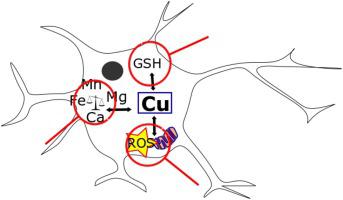Journal of Trace Elements in Medicine and Biology ( IF 3.6 ) Pub Date : 2021-01-14 , DOI: 10.1016/j.jtemb.2021.126711 Barbara Witt 1 , Michael Stiboller 1 , Stefanie Raschke 1 , Sharleen Friese 1 , Franziska Ebert 1 , Tanja Schwerdtle 2

|
Background
Being an essential trace element, copper is involved in diverse physiological processes. However, excess levels might lead to adverse effects. Disrupted copper homeostasis, particularly in the brain, has been associated with human diseases including the neurodegenerative disorders Wilson and Alzheimer’s disease. In this context, astrocytes play an important role in the regulation of the copper homeostasis in the brain and likely in the prevention against neuronal toxicity, consequently pointing them out as a potential target for the neurotoxicity of copper. Major toxic mechanisms are discussed to be directed against mitochondria probably via oxidative stress. However, the toxic potential and mode of action of copper in astrocytes is poorly understood, so far.
Methods
In this study, excess copper levels affecting human astrocytic cell model and their involvement in the neurotoxic mode of action of copper, as well as, effects on the homeostasis of other trace elements (Mn, Fe, Ca and Mg) were investigated.
Results
Copper induced substantial cytotoxic effects in the human astrocytic cell line following 48 h incubation (EC30: 250 μM) and affected mitochondrial function, as observed via reduction of mitochondrial membrane potential and increased ROS production, likely originating from mitochondria. Moreover, cellular GSH metabolism was altered as well. Interestingly, not only cellular copper levels were affected, but also the homeostasis of other elements (Ca, Fe and Mn) were disrupted.
Conclusion
One potential toxic mode of action of copper seems to be effects on the mitochondria along with induction of oxidative stress in the human astrocytic cell model. Moreover, excess copper levels seem to interact with the homeostasis of other essential elements such as Ca, Fe and Mn. Disrupted element homeostasis might also contribute to the induction of oxidative stress, likely involved in the onset and progression of neurodegenerative disorders. These insights in the toxic mechanisms will help to develop ideas and approaches for therapeutic strategies against copper-mediated diseases.
中文翻译:

以氧化应激标记物为重点表征人星形胶质细胞系中过量铜水平的影响
背景
作为一种必需的微量元素,铜参与多种生理过程。然而,过量的水平可能会导致不利影响。破坏的铜稳态,特别是在大脑中,与人类疾病有关,包括神经退行性疾病威尔逊和阿尔茨海默病。在这种情况下,星形胶质细胞在大脑中铜稳态的调节中发挥重要作用,并可能在预防神经元毒性方面发挥重要作用,因此指出它们是铜神经毒性的潜在靶点。讨论了可能通过氧化应激针对线粒体的主要毒性机制。然而,迄今为止,人们对铜在星形胶质细胞中的毒性潜力和作用方式知之甚少。
方法
在这项研究中,研究了影响人类星形胶质细胞模型的过量铜水平及其参与铜的神经毒性作用模式,以及对其他微量元素(锰、铁、钙和镁)体内平衡的影响。
结果
铜在培养 48 小时(EC 30:250 μM)后在人星形胶质细胞系中诱导显着的细胞毒性作用并影响线粒体功能,如通过线粒体膜电位降低和 ROS 产生增加所观察到的,可能源自线粒体。此外,细胞 GSH 代谢也发生了改变。有趣的是,不仅细胞铜水平受到影响,而且其他元素(Ca、Fe 和 Mn)的稳态也被破坏。
结论
铜的一种潜在毒性作用方式似乎是对线粒体的影响以及在人类星形胶质细胞模型中诱导氧化应激。此外,过量的铜水平似乎与其他基本元素(如 Ca、Fe 和 Mn)的稳态相互作用。被破坏的元素稳态也可能有助于诱导氧化应激,可能与神经退行性疾病的发生和进展有关。这些对毒性机制的见解将有助于开发针对铜介导的疾病的治疗策略的想法和方法。











































 京公网安备 11010802027423号
京公网安备 11010802027423号